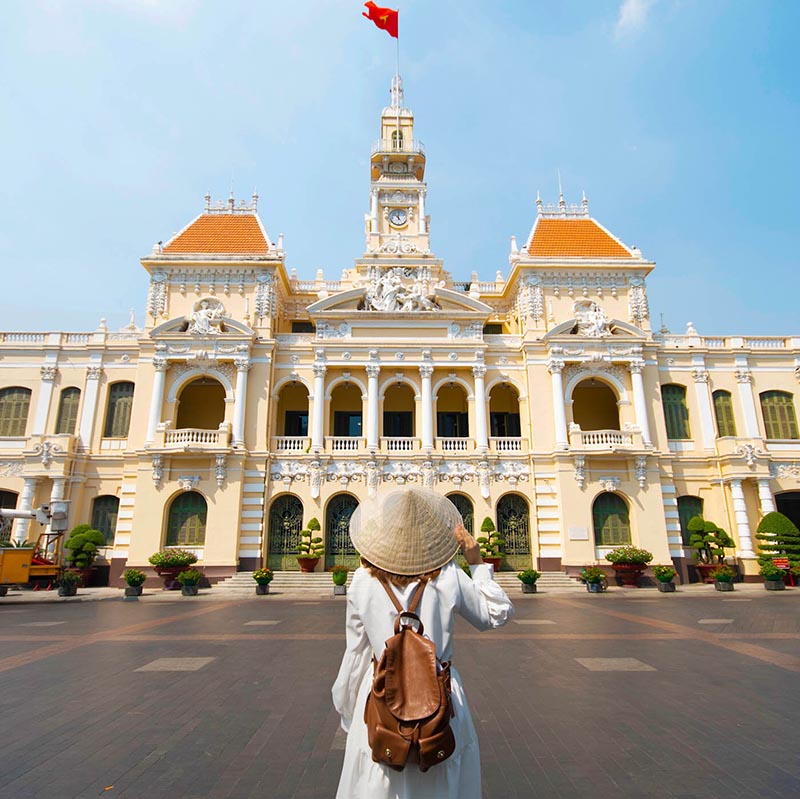Phở (Pho)
When it comes to traditional foods in Vietnam, Pho is undoubtedly the first dish that comes to mind. The dish is one of the most popular and widely enjoyed dishes in Vietnam. While it may not be considered rare, the taste of Pho always brings a delightful and comforting experience to every diner.
Introduction to the history of the dish: Vietnamese Pho is believed to have originated in the northern region of Vietnam between 1910 and 1913. The first Pho shops appeared as mobile noodle stalls in Hanoi. By the 1930s, Pho had become a beloved and commonly consumed dish among the Hanoi locals.
Taste: In the northern regions, Pho is known for its savory taste, while in the southern regions, it adopts a sweeter profile complemented by a wide array of vegetables. This culinary diversity highlights the richness of traditional foods in Vietnam, influenced by regional distinctions and local ingredients, resulting in distinct flavors and dining experiences.
Ingredients: The common ingredients used in a bowl of Pho include:
-
Beef or pork bones, rice noodles, onions, lemongrass, shallots and ginger.
-
Broth: Dried cinnamon, cardamom, tangerine peel, star anise, cloves and coriander seeds.
-
Accompaniments: Scallions, cilantro, coriander, lime, chili, basil and pickled vegetables.
-
Pho Seasoning: Salt, fish sauce, seasoning and rock sugar.
Where to find it: For an authentic taste of Hanoi-style Pho, you can visit:
-
Pho Thin (61 Ward Dinh Tien Hoang, Ly Thai To, Hoan Kiem)
-
Pho Bat Dan (49 Bat Dan Ward, Cua Dong, Hoan Kiem)
-
Pho 10 Ly Quoc Su (10 Ly Quoc Su, Hoang Minh Giam, Thanh Xuan)
-
Pho Sung (24, Trung Yen Alley, Dinh Liet, Hoan Kiem)
Price: The average price for a bowl of Pho ranges from 30,000 VND to 100,000 VND (approximately $1.3 to $4.3 USD).

Most tourists often choose Phở when they want to experience traditional Vietnamese cuisine.
Bánh mì (Banh mi)
In addition to Pho, Banh mi is another traditional food in Vietnam that is worth mentioning. Banh mi, which originated during the French colonial era, has become an iconic and beloved dish that represents the pride of the Vietnamese people and the essence of Vietnamese cuisine. This delectable combination of a crispy baguette filled with various savory ingredients such as grilled meats, pickled vegetables, herbs, and sauces, exemplifies the rich culinary heritage and diverse traditional foods in Vietnam.
Introduction to the history of the dish: In Vietnam, the first loaves of bread were introduced by the French colonialists in 1859, known as baguettes. Under the skillful hands of Vietnamese bakers, these loaves of bread acquired a distinct Vietnamese character.
Taste: The taste of banh mi can vary depending on the type, but the characteristic feature of these sandwiches is the aromatic scent of the bread itself.
Where to find it: You can experience authentic Vietnamese Bánh mì at places like:
-
Banh Mi Hoang Duc (55 Chua Lang, Dong Da, Hanoi)
-
Banh Mi Tram (30 Dinh Ngang, Cua Nam Ward, Hoan Kiem District, Hanoi)
-
Banh Mi Lan Ong (8 Cha Ca, Hanoi)
-
Banh Mi Ba Dan (34 Lo Su, Hoan Kiem, Hanoi)
Price: The average price for enjoying a Banh mi ranges from 12,000 VND to 66,000 VND
(approximately $0.52 to $2.86 USD).
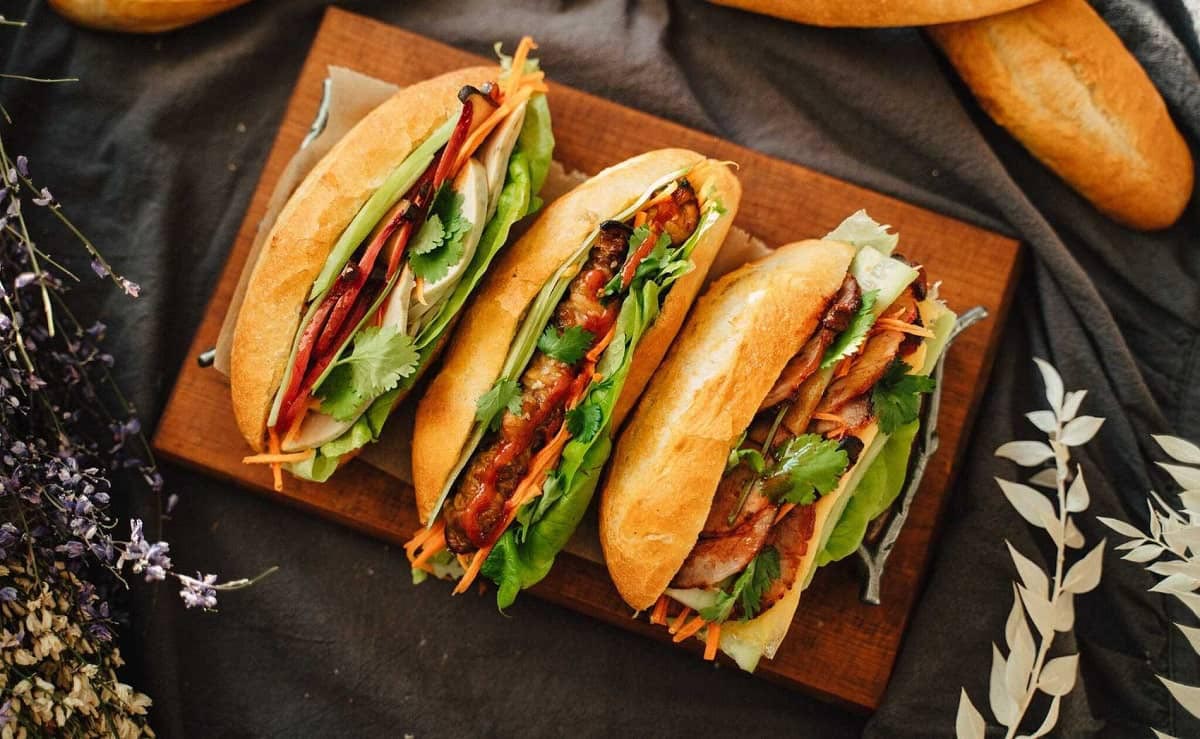
Bánh mì is a must-try dish when visiting Vietnam.
Bún chả (Bun cha)
Similar to Phở and Bánh mì, Bún chả has become a staple in Vietnamese cuisine, showcasing the variety and abundance of traditional foods in Vietnam. With basic and humble ingredients, this dish provides locals and tourists with the opportunity to savor the true flavors of the past.
Introduction to the history of the dish: Many believe that Bun Cha originated in the 18th century, although there is no definitive source to confirm this. However, Bun Cha has been a long-standing dish in Hanoi and continues to be a culinary tradition to this day.
Taste: Bun cha combines rice vermicelli noodles and grilled pork patties, served with a savory and sweet dipping sauce, creating a dish with a delightful and enticing flavor that captivates many tourists.
Ingredients: The main ingredients of bun cha typically include:
-
Chả: Minced pork shoulder for the patties and pork belly for the grilled slices.
-
Bún: Rice vermicelli noodles.
-
Dipping sauce: Diluted fish sauce mixed with various seasonings such as sugar, monosodium glutamate, lime juice, vinegar, minced garlic, minced chili and cà cuống essence.
-
Pickled vegetables: Green papaya (or carrot, jicama, onion).
-
Fresh herb plate: Lettuce, Vietnamese balm, cilantro and perilla.
-
Additional condiments: Minced garlic, minced chili, vinegar, ground black pepper and sliced kumquat.
Where to find it: If you're looking to try authentic Bun Cha in Vietnam, you might want to check out these places:
-
Bun Cha Sinh Tu (02 Nguyen Phong Sac, Cau Giay, Hanoi)
-
Bun Cha Huong Lien (24 Le Van Huu, Hai Ba Trung District, Hanoi)
-
Bun Cha Dac Kim (Dac Kim, Hang Manh, Hoan Kiem, Hanoi)
-
Bun Cha in the Old Quarter (Alley 74 Hang Quat, Hanoi)
Price: The price for a serving of bun cha at these locations ranges from 25,000 VND to 40,000 VND (approximately $1.09 to $1.74 USD).

Bún chả is an essential dish that you shouldn't miss when exploring Vietnam.
Bún bò Nam Bộ (Bun bo Nam bo)
When you visit Vietnam, you definitely cannot miss out on Bun bo. It is a popular and traditional foods in Vietnam. Bun bo has cemented its status as a beloved classic in Vietnamese cuisine, enticing food lovers with its delightful blend of delectable and savory flavors. Additionally, Bun bo Nam Bo is included in the list of 40 delicious dishes in Vietnamese cuisine and is among the top 10 street foods in Vietnam.
Introduction to the history of the dish: This is a popular dish in the Southern region of Vietnam. However, there is no consensus on the origin of the name Bun bo Nam Bo and there are differing opinions.
Taste: Bun bo Nam Bo captivates many tourists with its distinct flavors derived from fresh herbs, stir-fried beef, and the sweet-sour fish sauce dressing.
Ingredients: The ingredients used in its preparation include:
-
Rice vermicelli noodles.
-
Stir-fried beef.
-
Fried shallots, bean sprouts, fresh herbs, crushed peanuts and pickled papaya.
-
Sweet-sour dressing.
Where to find it: You can savor delicious Bun bo Nam Bo at various locations such as:
-
Bun bo Nam Bo 79 Chua Lang (79 Chua Lang, Cau Giay, Hanoi)
-
Bun bo Nam Bo Co Tuan (49C Tran Quoc Toan, Hoan Kiem District, Hanoi)
-
Bun bo tron 109A5 Thanh Cong (109A5 Thanh Cong Housing Area, Dong Da District, Hanoi)
-
Bun tron Nam bo, Alley 111 Khuong Thuong (12 Alley 111 Khuong Thuong, Dong Da District, Hanoi)
Price: The average price for a bowl of Bun bo Nam Bo ranges from 30,000 to 50,000 VND (approximately $1.36 to $2.27 USD).
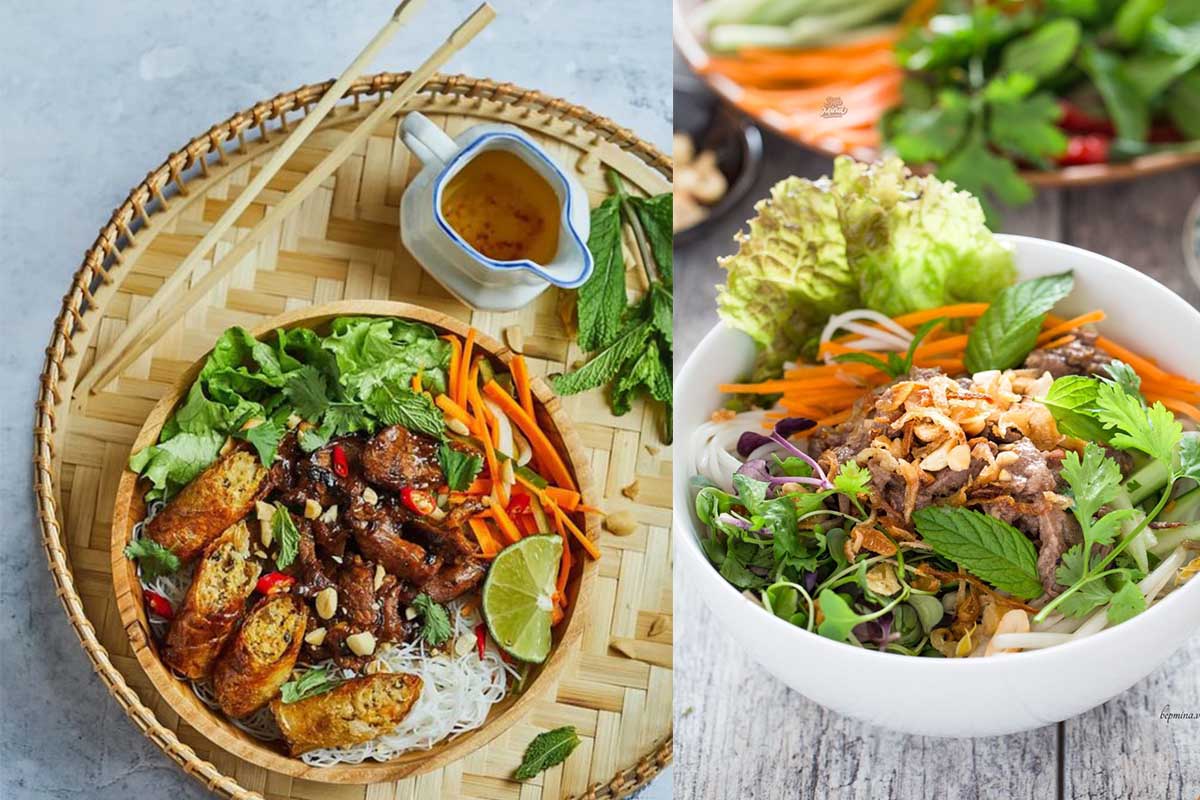
Don't forget to indulge in the exquisite flavors of Bún bò Nam Bộ during your time in Vietnam.
Hủ tiếu (Hu tieu)
To begin your exploration of traditional foods in Vietnam, it is essential to include Hu tieu on your list. This popular dish is loved by Vietnamese people across the country and is particularly known as a specialty of Saigon. For seafood enthusiasts, Hu tieu is an absolute must-try.
Introduction to the history of the dish: Hu tieu is widely popular in Vietnam, especially in the southern region since the 1950s, with the largest number of vendors found in Saigon. It is easy to find Hu tieu stalls along the streets or mobile Hu tieu carts at the beginning of alleys.
Taste: The distinct flavor of Hu tieu comes from its combination of seafood and a subtly sweet broth, enriched by a medley of familiar spices. Every bowl of Hu tieu embodies the authentic taste that captivates the local palate.
Ingredients: The main ingredients commonly found in Hu tieu include:
-
Hu tieu noodles.
-
Meat (pork, poultry) or seafood.
-
Broth (made from pork bones, vegetables)
Where to find it: You can experience the flavors of "Hu tieu" at places like:
-
Hu Tieu Bo Vien 1122 (Alley 1046 Truong Sa Street, Ward 12, District 3, Ho Chi Minh City)
-
Hu Tieu Nam Vang Nhan Quan (122D Cach Mang Thang 8 Street, Ward 7, District 3, Ho Chi Minh City)
-
Hu Tieu Cua Tron Thanh Xuan (109A5 Thanh Cong Housing Area, Dong Da District, Hanoi)
-
Hu Tieu Ho (237 Cao Van Lau Street, District 6, Ho Chi Minh City)
Price: The average price for a bowl of Hu tieu one of the traditional foods in Vietnam, ranges from 30,000 to 120,000 VND (approximately to 1.3 to 5.2 USD).
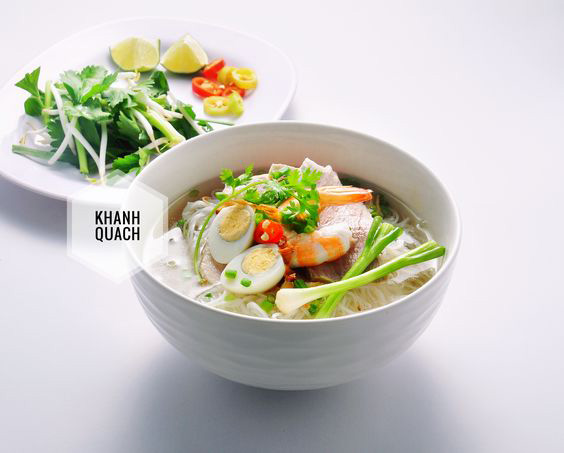
Hủ tiếu is a popular Vietnamese noodle dish that you shouldn't miss.
Bánh cuốn (Banh cuon)
Bánh Cuốn, also known as "steamed rice rolls" (when served without filling), is a popular traditional meal in Vietnam and is considered one of the many iconic traditional foods in Vietnam. It is a rustic dish made from familiar recipes, but these rice rolls have left an impression on many visitors who have tried them.
Introduction to the history of the dish: Currently, there is no specific timeline regarding the origin of Banh cuon, but according to folklore in Thanh Tri village, people have gathered here to cultivate the land since the time of Hung Vuong, the legendary founder of Vietnam. An Quoc, the 18th Hung Vuong king's son, is said to have taught the people how to make Banh cuon.
Taste: Banh cuon has a taste of rice combined with various spices to create a diverse range of flavors. The dish is enhanced with the fragrant crispness of fried shallots and a touch of irresistible crispy rendered fat. It is beautifully accompanied by a dipping sauce that achieves a harmonious blend of sweet and tangy flavors.
Ingredients: The main ingredients of banh cuon are rice flour, vegetables, and meat, but there are variations in cooking methods depending on the region.
Where to find it: You can try banh cuon at places such as:
-
Banh Cuon Ba Hanh (26B Tho Xuong, Phu Doan, Hoan Kiem District, Hanoi)
-
Banh Cuon Gia Truyen - Thanh Van (81 Le Van Huu, Hai Ba Trung District, Hanoi)
-
Quan Banh Cuon Minh Tu (57 Nguyen Hau, Tan Thanh Ward, Tan Phu District, Ho Chi Minh City)
-
Banh Cuon Thien Huong (179A 3 Thang 2 Street, Ward 11, District 10, Ho Chi Minh City)
Price: The average price to enjoy a box of Banh cuon is around 15,000 VND to 39,000 VND (approximately $0.65 to $1.70).
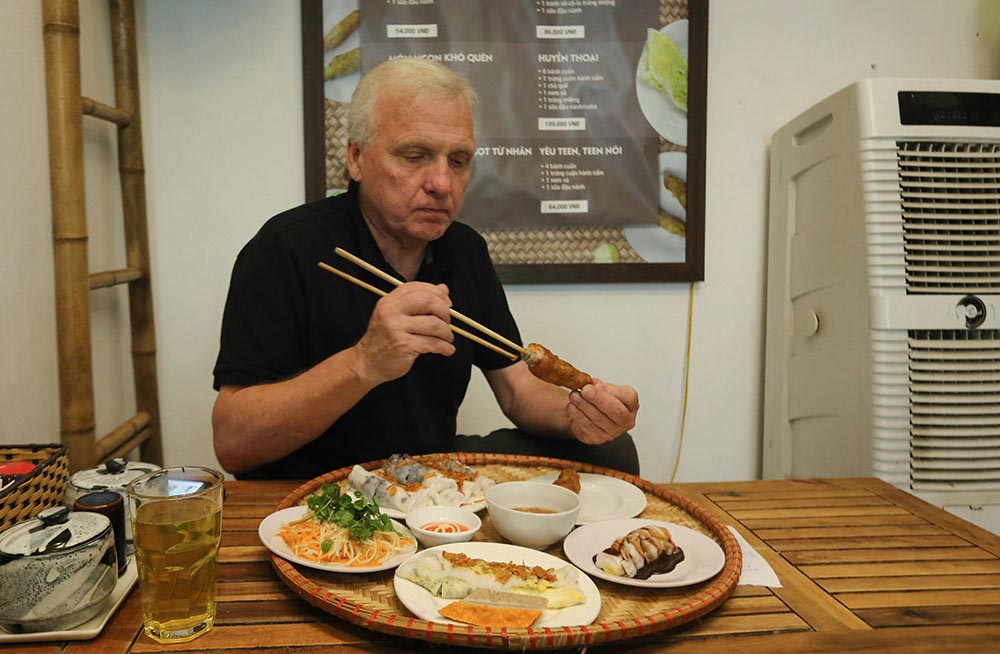
Bánh cuốn is an irresistible choice that should not be overlooked by food enthusiasts.
Discover additional information in our Travel guide to Vietnam!
Bánh xèo (Banh xeo)
Banh xeo is famous for its strong representation of Vietnamese cuisine, captivating the taste buds of both locals and international tourists. This iconic dish holds a special position among traditional foods in Vietnam. Its versatility allows for year-round enjoyment, making it a timeless favorite for food enthusiasts to explore the rich culinary heritage of Vietnam. In addition, Banh xeo, with its crispy texture and delicious fillings, is often likened to the Vietnamese version of a pizza, offering a unique twist on traditional flavors.
Introduction to the history of the dish: Banh xeo is a long-standing dish of the locals, part of Vietnam, a country with a developed rice industry, so it can be said that this dish has been around for a very long time.
Taste: The dish has a distinctive flavor of rice, mung beans, and seafood that creates an unforgettable taste that many people love.
Ingredients: The main ingredients to make Banh xeo are easy to find and simple, such as rice flour, water, turmeric powder, pork, shrimp and bean sprouts.
Where to find it: You can experience the dish of Banh xeo at places such as:
-
Banh Xeo Binh Dinh Nau Oi (63b Ung Van Khiem, Ward 25, Binh Thanh District, Ho Chi Minh City).
-
Banh Xeo Ngoc Son (103 Nguyen Quyen Street, Ward 11, District 5, Ho Chi Minh City).
-
Banh Xeo Tu Dong (29 Vu Tong Phan Street, Thanh Xuan District, Hanoi).
-
Banh Xeo Da Nang Nguyen Khuyen (89 Nguyen Khuyen, Dong Da District, Hanoi).
Price: The average price to enjoy a serving of Banh Xeo is around 20,000 to 60,000 VND (approximately $0.87 to $2.61).
This is one of the traditional foods in Vietnam offers a delightful culinary experience that is worth every penny.
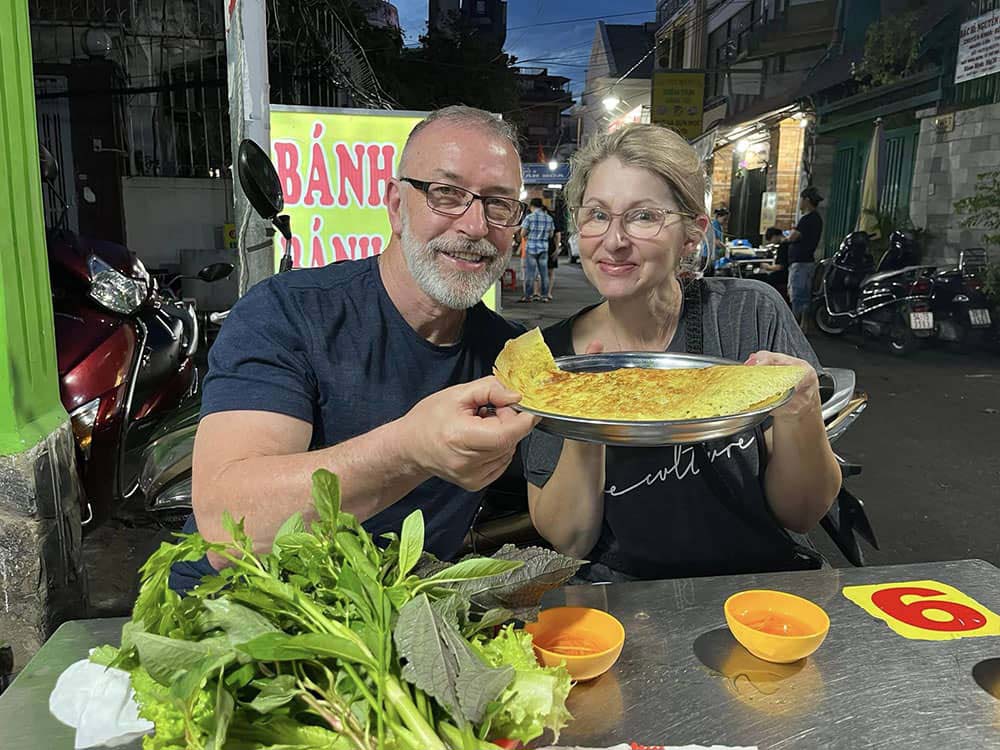
Bánh xèo is a culinary treasure for food-loving tourists.
Cơm tấm (Com tam)
Saigon is a must-visit destination for food enthusiasts, offering a delightful array of traditional foods in Vietnam. Among them, the renowned broken rice dish stands out as a culinary gem. Originating in Saigon, this beloved traditional delicacy, known as Com tam, has gained popularity throughout the country and receives praise from visitors worldwide.
Introduction to the history of the dish: Initially, it was a popular dish among farmers and workers in the Mekong Delta region. During years of poor harvest, many people did not have enough good-quality rice to sell, so they used broken rice to make Com tam, which has become a popular dish until now.
Taste: There are many ways to prepare Com tam, depending on the region. Each dish of Com tam is prepared with different ingredients, resulting in different tastes.
Ingredients: The main ingredients to make a plate of com tam are broken rice, grilled pork chop, mixed fish sauce, pickled vegetables, cucumber, tomato and scallion oil.
Where to find it: You can experience the dish of com tam at places like:
-
Com suon Ba Cuong (263 Tran Quang Khai, Tan Dinh Ward, District 1, Ho Chi Minh City)
-
Com tam Minh Long (607 Nguyen Thi Thap, District 7, Ho Chi Minh City)
-
Com tam Phuong Anh (119A6 Tran Huy Lieu, Giang Vo Ward, Ba Dinh District, Hanoi)
-
Com tam Thuy Linh Chau (53-59 Trang Thi, Hoan Kiem District, Hanoi)
Price: The average price to enjoy a box of broken rice ranges from 30,000 VND to 80,000 VND (approximately $1.31 to $3.48).
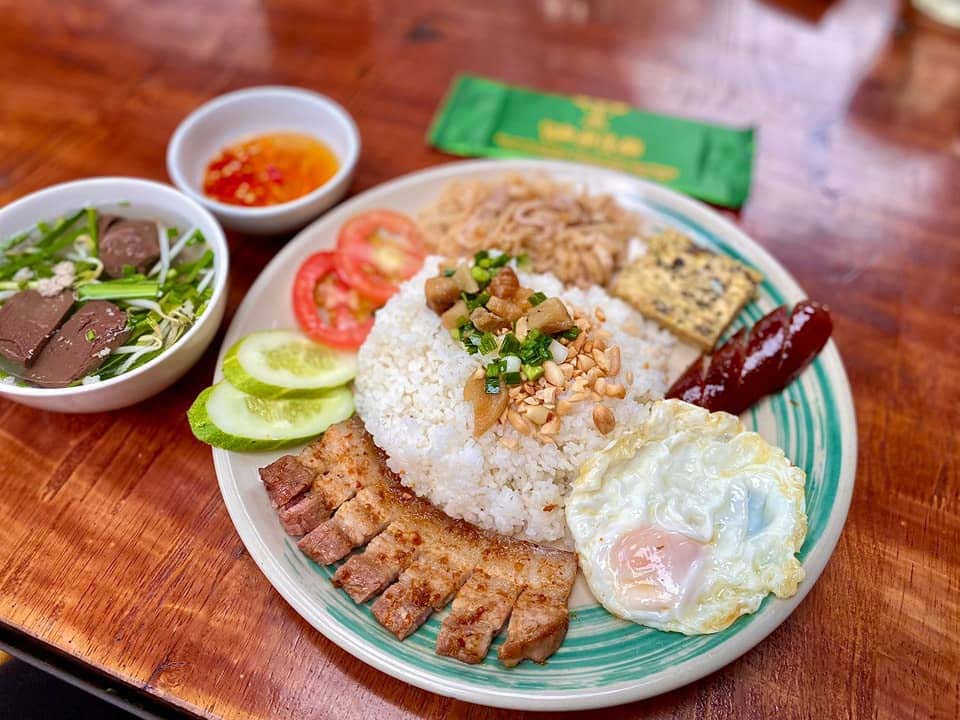
Cơm tấm is a culinary treasure that should be at the top of your list when visiting Saigon.
This article has summarized the traditional foods in Vietnam that we want to share with you. We hope that you will take the time to discover these delicacies. We sincerely thank you for following the article and look forward to seeing you again in other interesting content. And if you are looking for quality tour package to Vietnam, please contact us for more details.




